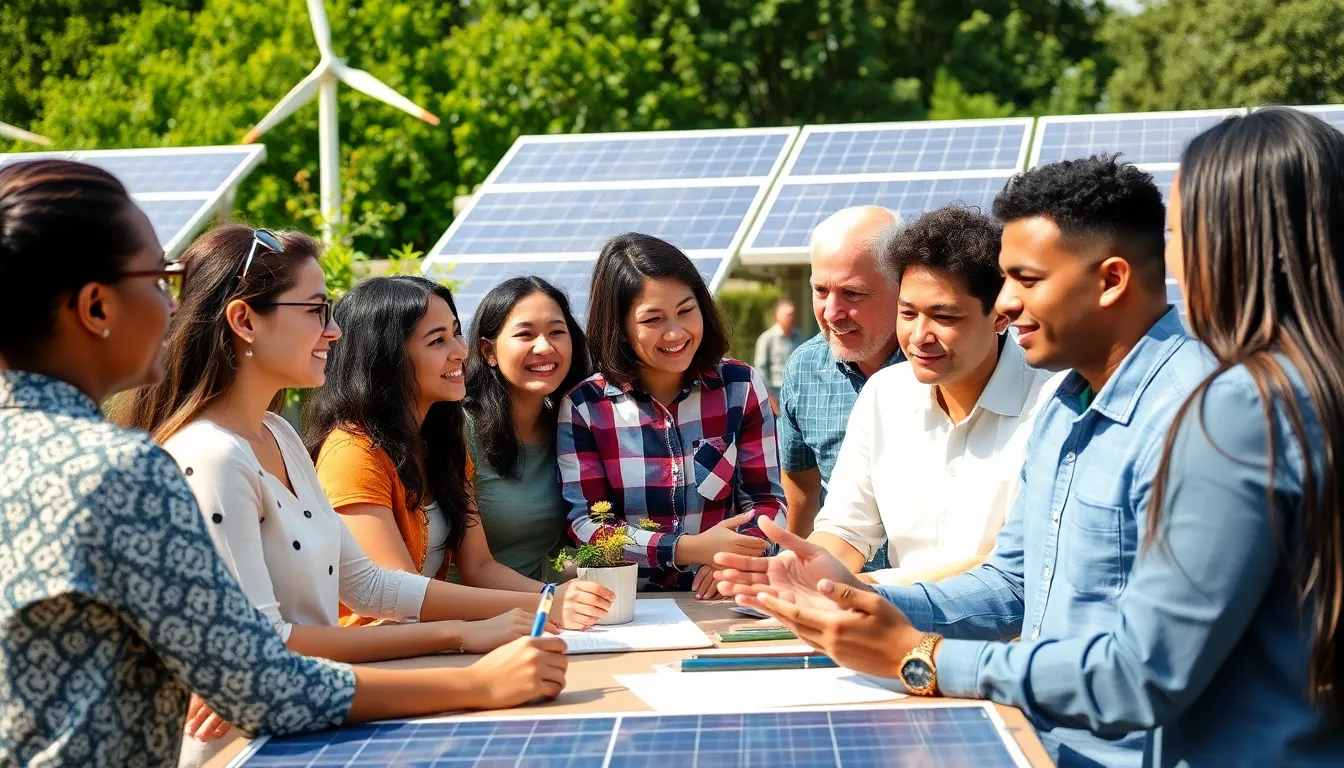In a world where plastic straws are the new villain and eco-friendly heroes are on the rise, sustainability innovation is the superhero we didn’t know we needed. It’s not just about saving the planet; it’s about making life a little more fabulous while doing it. Imagine a future where your coffee cup not only fuels your caffeine addiction but also decomposes faster than your New Year’s resolutions. Sounds dreamy, right?
Sustainability innovation is shaking things up in ways that make even the most skeptical among us sit up and take notice. From groundbreaking materials to energy-efficient technologies, this movement is proving that being green can be both practical and stylish. Buckle up as we dive into the exciting realm of sustainability innovation, where creativity meets responsibility and every bright idea could lead to a brighter future.
Table of Contents
ToggleUnderstanding Sustainability Innovation
Sustainability innovation addresses environmental challenges through creative solutions. This movement fosters eco-friendly practices that improve both planetary health and daily living.
Definition and Importance
Sustainability innovation refers to developing new methods, products, or services that support environmental preservation. Businesses embrace this concept to minimize their ecological footprint while meeting consumer demand for responsible choices. Engaging in sustainability innovation demonstrates corporate social responsibility and enhances brand reputation. The importance of this movement lies in its potential to drive systemic change, promote resource conservation, and stimulate economic growth through green technologies.
Key Concepts
Several key concepts underpin sustainability innovation. Circular economy emphasizes maximizing resource use while minimizing waste. Energy efficiency focuses on reducing energy consumption in processes and product designs. Sustainable supply chains seek ethical sourcing and environmentally friendly practices at every production stage. Social equity highlights the need for inclusivity, ensuring that innovation benefits diverse communities. Embracing these concepts drives progress towards a more sustainable future, balancing ecological needs with economic development.
Types of Sustainability Innovations

Sustainability innovations manifest in various forms, actively addressing environmental challenges. Understanding the different types helps to appreciate their impact.
Technological Innovations
Technological innovations focus on developing advanced tools and systems. These innovations include renewable energy sources like solar panels and wind turbines, which significantly reduce reliance on fossil fuels. Smart grids also enhance energy efficiency by optimizing electricity distribution. Furthermore, biotechnology brings breakthroughs in creating eco-friendly materials, such as biodegradable plastics. These technologies represent vital components in the shift towards a more sustainable future.
Process Innovations
Process innovations enhance operational efficiency while minimizing waste. Techniques such as lean manufacturing aim to streamline production, reducing resource consumption. Sustainable sourcing ensures that raw materials are obtained responsibly, promoting ethical practices across supply chains. Additionally, adopting circular economy principles transforms waste into valuable resources, creating a closed-loop system. These innovations not only lower environmental impacts but also improve overall business resilience.
Social Innovations
Social innovations prioritize societal benefits alongside environmental goals. Community-driven initiatives promote sustainable practices through education and awareness programs. Collaborative consumption models, like car-sharing services, cultivate resource-sharing, decreasing individual ownership and reducing carbon footprints. Moreover, inclusive business practices foster social equity by engaging marginalized communities in sustainability efforts. These innovations create a holistic approach to sustainability, addressing both ecological and social dimensions.
Case Studies of Successful Sustainability Innovations
Innovations in sustainability showcase real-world applications that significantly impact both the environment and communities. These case studies highlight transformative solutions across various sectors.
Renewable Energy Solutions
Solar energy systems have emerged as a frontrunner in renewable energy solutions. Companies like Tesla focus on solar panels and energy storage, enabling households to harness the sun’s power. Wind farms also contribute, generating electricity with minimal environmental impact. In Denmark, wind power supplies about 47% of the nation’s energy needs. These innovations reduce reliance on fossil fuels and foster energy independence throughout regions. Call to action supports businesses to invest in these sustainable technologies.
Sustainable Agriculture Practices
Practices in sustainable agriculture demonstrate an innovative approach to food production. Regenerative farming, for example, enhances soil health while increasing crop yields. Techniques include cover cropping and crop rotation, minimizing chemical inputs and conserving water. A report from the Rodale Institute indicates that regenerative practices can sequester up to 2.6 billion tons of CO2 annually in the U.S. Vertical farming is also gaining traction, using less space and resources to produce food in urban areas. These methods create food systems that are both environmentally friendly and economically viable.
Challenges and Barriers to Sustainability Innovation
Sustainability innovation faces several challenges and barriers, impacting its adoption and effectiveness across industries.
Economic Obstacles
Economic challenges impede the development and implementation of sustainability innovations. Many companies struggle with high initial investment costs associated with new technologies, leading to a risk-averse mentality. Budget constraints often restrict smaller businesses from pursuing innovative projects. Additionally, the perception of sustainability as an added expense rather than a long-term investment hinders growth. These barriers create a significant gap between the willingness to innovate and the available resources. For instance, only 30% of small businesses invest in eco-friendly practices, largely due to financial concerns. Without financial support mechanisms, such as grants or incentives, many organizations cannot shift toward sustainable alternatives.
Regulatory Issues
Regulatory hurdles often complicate the landscape for sustainability innovation. Complex and fragmented regulations can create confusion for businesses trying to comply with environmental standards. Varying policies across regions may discourage companies from pursuing sustainable practices. Regulations that lack clarity can lead to increased compliance costs and legal risks. Innovations sometimes fall behind existing regulations, creating a hesitation to adopt new technologies. For example, 60% of businesses cite regulatory uncertainty as a barrier to investing in renewable energy projects. Overcoming these challenges requires streamlined policies that promote sustainability while incentivizing innovation.
Future Trends in Sustainability Innovation
Innovations in sustainability are rapidly evolving, focusing on creating a more eco-friendly future. Key trends include emerging technologies and collaborative approaches that enhance effectiveness in this field.
Emerging Technologies
Innovative technologies shape the sustainability landscape significantly. Solutions like artificial intelligence and blockchain improve efficiency in resource management and supply chain transparency. These technologies enable organizations to analyze data for sustainable practices effectively. Additionally, advancements in biotechnology are revolutionizing agriculture by creating pest-resistant crops with lower pesticide use. Renewable energy technologies continuously evolve, showcasing increased efficiency and lower costs. For example, solar panel efficiency has improved by 20% in the last decade. These developments illustrate the potential to reduce carbon footprints and foster sustainable practices across various industries.
Collaborative Approaches
Collaboration amplifies the impact of sustainability efforts. Companies partner with NGOs to develop initiatives that promote environmental stewardship and social responsibility. Joint ventures in the renewable energy sector facilitate the sharing of knowledge and resources, accelerating innovation. Furthermore, stakeholders now engage in multi-sector partnerships that address systemic issues, such as water scarcity and air pollution. Community-driven projects empower individuals and promote inclusive practices that align with sustainability goals. These collaborative approaches highlight the importance of collective action in fostering a sustainable future.
Sustainability innovation stands as a beacon of hope in the quest for a healthier planet. By merging creativity with responsibility, it paves the way for eco-friendly solutions that resonate with consumers and businesses alike. The drive towards a circular economy and enhanced social equity reflects a growing recognition of the interconnectedness of environmental and societal well-being.
As challenges persist, the commitment to innovative practices will be vital. Future advancements in technology and collaborative efforts can further propel this movement, ensuring that sustainability becomes a standard rather than an exception. Embracing these innovations not only benefits the environment but also fosters economic resilience, creating a brighter future for all.



